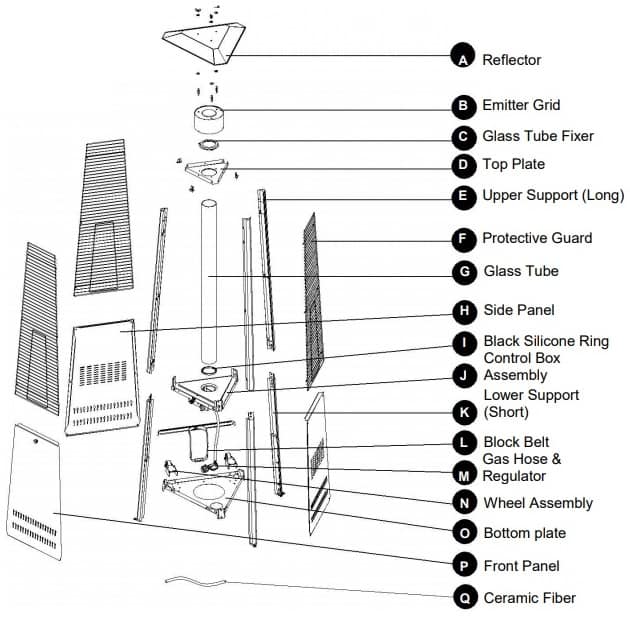The best way to transport a patio heater is to disassemble it first. When disassembled, it will be easier to transport it freely without damaging it.
It is also much easier to transport a patio heater using a truck and equipment to assist in the moving.
When moving the disassembled patio heater, inspect it thoroughly to avoid missing items.
There are a lot of benefits patio heaters can add to your outdoor space in addition to warmth.
Patio heaters can enhance your outdoor space a little more.
Along with their beautiful design, patio heaters are pretty delicate.
When relocating or redecorating, you may damage your patio heater with accidental movement, and want to be very careful when transporting.
There are different things to note when you transport a patio heater.
In this article, we will be answering questions regarding the best ways to transport a patio heater.

Related Reading: The Best Patio Heaters With Wheels [BUYER’S GUIDE]
Table of Contents
Is Transporting a Portable Patio Heater Safe?
A portable patio heater is great for an outdoor space and offers tremendous versatility, enabling you to engage outdoors throughout the year.
When you transport a patio heater, it is vital to take specific care of the heater to avoid injuring yourself and damaging your heater.
Ensure you don’t transport a patio heater while the flame is open.
When you move the patio heater while it’s open, it disrupts the flow of gas and increases the risk of damaging the valves of the hoses.
This can expose leaking gas to any ignition and cause a fire hazard.
Additionally, do not move the patio heater on your own. Though portable, it still has some heavy and delicate parts.
If you do not apply some technical knowledge to transporting the heater, you can risk injury to your back.
Disassembling Your Patio Heater
If you have a patio heater, there may have been a time when you wanted to move it or transport it.
Maybe you wanted the patio heater at a safe spot or a new location.
Most patio heaters can be disassembled into smaller parts.
If you have an electric heater, be sure to remove it from the power source before doing any disassembly.
If you have a gas-powered heater, remove the fuel source before disassembly.
Most of the labor is removing the bolts and screws and dismantling the heater in several parts.
If you are unsure of the steps to disassemble your patio heater, then you should leave it to a professional.
If you don’t know how to reassemble the patio heater, it increases the chances of it not working again.
It is best to leave disassembling the patio heater alone and call for an expert to handle the job.
These experts will certainly know how to disassemble and put it back together in working order.
Related Reading: Patio Heater Replacement Parts – What You Need to Know
Can You Use A Truck To Transport A Patio Heater
Yes, you can use a truck to transport a patio heater.
It is probably the safest way to move a patio heater between different locations.
Trucks allow for more effortless loading and use of special transporting equipment like hand trucks.
Once you get the patio heater to its new location, you can use a hand truck or dolly to move it out of the vehicle.
Secure any ramps or loading equipment that helps lift or lower the heater.
Unless you have a pickup truck, transporting a patio heater without disassembling it is challenging.
You can also damage the heater or it might not fit into your truck.
And it has to be done carefully not to damage parts of the patio heater.
Maintenance of Your Patio Heater
When the patio heater you are transporting is not new, now would be a good time for inspection and cleaning.
Take the time to clean the patio heater and repair or replace some parts worn out or not functional.
Cleaning your patio heater can be very simple and easy. If you have done the technical part of disassembling the patio heater, everything else will be much easier.
You can clean the patio heater using warm water, a damp cloth, and soap.
You should, however, be careful not to rough the surfaces with abrasive cleaners.
Potent cleaning agents and chemicals could also damage your patio heater.
Consult your patio heater operating manual for specific instructions regarding maintenance and cleaning.
Aside from cleaning the patio heater, you should also inspect the heater for missing parts or areas that need repairs or replacement.
This is the best time to ensure your patio heater is in working order.
Assembling A Patio Heater
Assembling a patio heater is relatively simple.
This shouldn’t be too difficult if you know how to use a hammer, screwdriver, and wrench.
You can follow the assembly instructions in your owner’s manual for a step-by-step guide.
Most patio heater guides have a diagram showing the parts.

Most patio heaters require at least two people to assemble them. You may have some heavy features and awkward balancing of material.
Most times, the tools you will need to assemble the patio heater are an open wrench for bolts and nuts, a screwdriver, and a crescent wrench.
If you are unsure what to do before transporting a patio heater, you should call a professional to dismantle it.
Make sure to consult your operating manual to know the type of patio heater you have. There are many different kinds of patio heaters requiring different assembling techniques.
Where Is The Best Place To Put A Patio Heater?
The portability of a patio heater makes it fit to be positioned almost anywhere.
This can be done without compromise to the sufficient levels of warmth.
The objects surrounding a heater can absorb the heat.
Furniture, floors, and walls can add to the absorption of heat. People also receive the energy that heaters create, which will spread as warm heat waves.
Most patio heaters work best when horizontally positioned on the wall.
Ensure the heater is high on a surface beyond children’s reach.
If you have a garden with an overhead trellis, you could position your patio heater there.
Make sure nothing that can catch fire is near the heater.
You must also ensure the structure is sturdy and robust enough to support the heater’s weight.
Most patio heaters using gas can be used in the rain. It isn’t the best practice, but you can use it if necessary.
It is best to avoid moisture while using the heater. Covering the heater when left outside and not in use is also recommended.
Please read this article if you have concerns about rain or snow damaging your patio heater.
Patio heaters are made of the highest quality material, making them highly durable.
Safety Tips for Patio Heater
Because of the dangers of using patio heaters, you must know how to operate and transport a patio heater without incident.
Here are a few safety tips:
- Patio heaters are designed for outdoor usage. Never attempt to use a patio heater indoors or in a closed structure like a tent. This is to avoid the risk of carbon monoxide poisoning.
- Your propane cylinders should be stored outdoors and not indoors. The cylinders must be safeguarded with vehicle-proof and tamper-proof protection with either a built fence or a locked cage. It must also be stored upright. If, for security reasons, you need to transport your patio heater indoors, kindly remove the propane cylinders before moving them.
- Before disassembling, transporting, and installing, please review the manufacturer’s instructions on distancing the heater from any fire hazard and building mechanical air intakes.
- Do not transport a patio heater while the flame is on. Shut off the fuel supply and let the unit cool before moving it.
- Remember to use CAUTION when transporting the propane cylinder, avoiding impact and falling to the ground.
- Do not leave the patio heaters unattended. Always keep an eye on them. And restrict children from getting close to the heater.
Continue Reading: How Much Ventilation Do Propane Heaters Need?
Conclusion
A patio heater is a perfect addition to your outdoor area. It helps you host friends and family year in and year out.
The patio heater may go as far as giving you a spa experience in the winter season.
Positioning your patio heater can be instrumental to having these benefits. This underscores the need for transporting it to an entertaining area.
Remember to always follow safety precautions before doing any disassembling of the heater. As always, if you feel your skills may be limited, call a professional to help with the dismantling.
You should be more confident to transport a patio heater without injuries or damage to the heater.
Enjoy the outdoor life!
